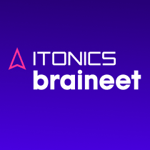In the past decades, research and development (R&D) expenses have surged across various industries. Between 2007 and 2022, corporate R&D spending grew with a CAGR of 5.2%, underscoring the importance of R&D in driving future growth and market differentiation (Global Innovation Tracker, 2023). With firms increasingly integrating advanced technologies like the Internet of Things (IoT), big data, and artificial intelligence into their product and service portfolios, R&D investments are expected only to increase further.
Despite the upward trajectory in R&D investments, there is a discernible disconnect between the resources allocated and the actual value and output generated. As an example, the figure below vividly illustrates the concerning pattern of diminishing R&D productivity within the biopharma sector since 1990 (Stott, 2017). Working with over 300+ leading corporations across the globe, we see similar trends manifesting in a broad range of industries. This productivity challenge puts considerable pressure on innovation executives, prompting a critical evaluation of R&D efficiency and effectiveness.
Addressing the need for improvement, this article will delve into the input dimension of R&D, aiming to equip Chief Technology Officers (CTOs) and innovation leaders with actionable strategies to improve cost and time efficiency. By exploring key hurdles in resource optimization and proposing coherent frameworks for improvement, the piece will guide R&D executives toward maximizing their departments' potential, ensuring that investment translates into tangible innovation and sustained organizational growth.
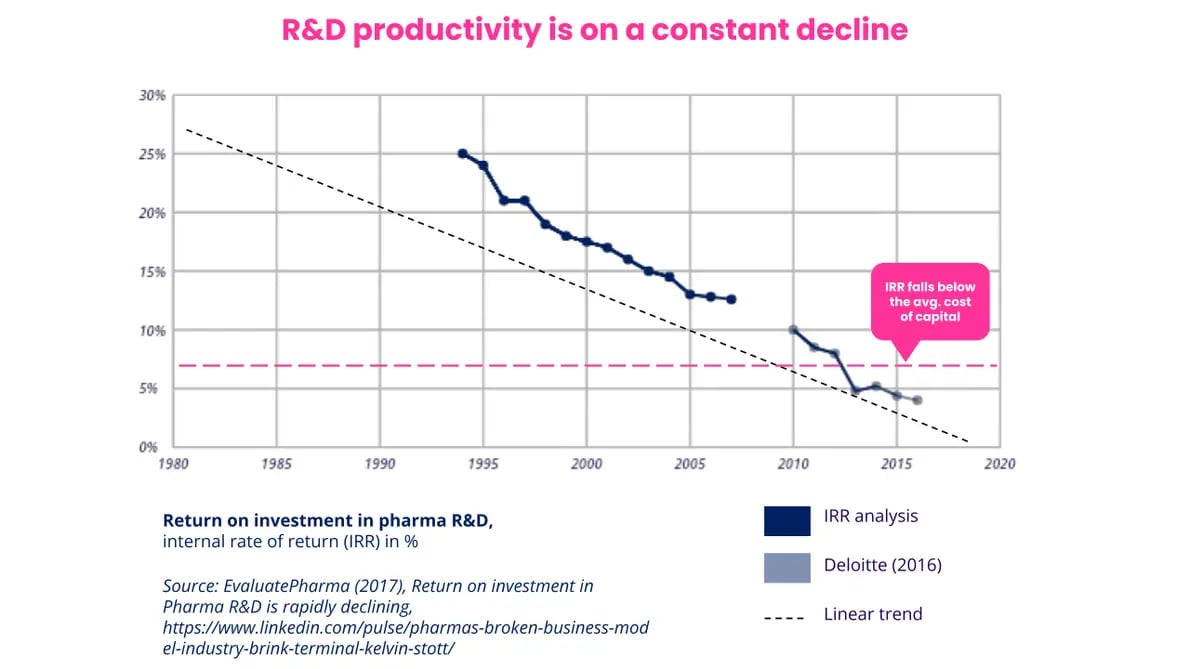
Key challenges affecting R&D productivity
The traditional operational framework of R&D organizations is typically characterized by distinct streams and teams dedicated to specific areas of expertise. This setup promotes high levels of functional specialization and adheres to a component-based logic, where tasks are executed sequentially. While methodically sophisticated, such a compartmentalized approach often results in siloed operations and might hinder the seamless integration and cross-functional collaboration essential for innovative R&D.
The conventional model is challenged by an escalating complexity in the business landscape. More and more R&D units operate in an environment characterized by an expanding web of interdependencies. The following prominent factors drive complexity today and will continue to do so in the foreseeable future:
- diversified and fast-changing customer demands necessitating customized features and a broadening of product and service portfolios,
- the need to integrate digital and electronic systems within physical hardware, leading to asynchronous development cycles and pressure to swiftly react to constant technological advancements,
- the pressures of globalization which mandate localized R&D efforts to cater to regional market specifics and result in decentralized operations that are difficult to monitor.
These factors collectively strain the traditional R&D frameworks, necessitating an evolved approach that can accommodate all the demands. Our overall diagnosis is that there is a clear mismatch between the structures, processes, and infrastructures in place compared to the tasks that must be accomplished.
Regarding resource optimization, the growing complexity in the R&D landscape manifests in a variety of hands-on challenges confronting R&D leaders in their daily work. To dig deeper and explore those challenges more specifically, we asked 143 R&D executives within and beyond our client base to state the key roadblocks for efficient R&D operations as experienced in their company. The figure below illustrates the top 12 challenges according to the evaluation by our respondents. In what follows, we will use those challenges as a starting point for developing effective solution strategies in R&D management.
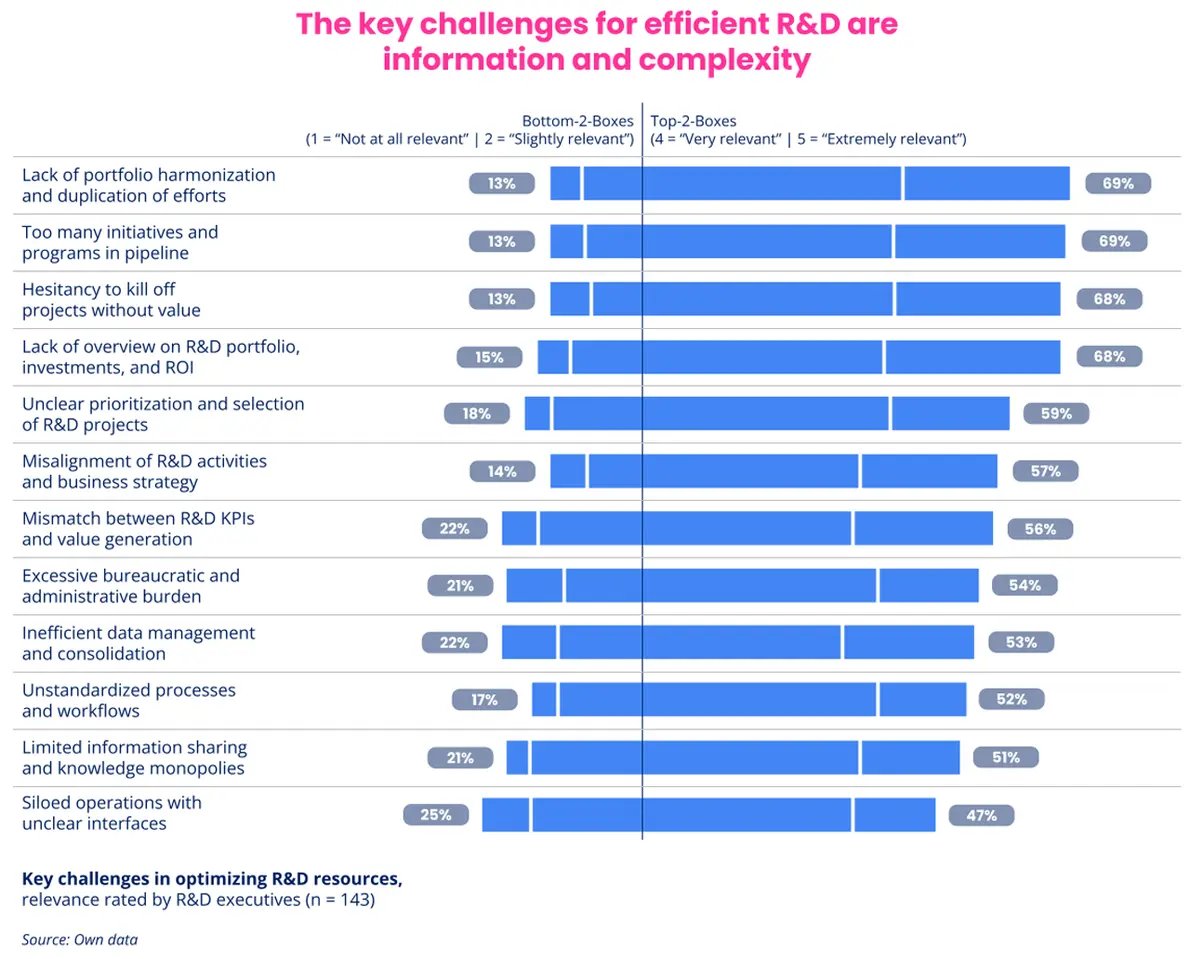
Four solution strategies for R&D executives
Based on the top 12 challenges identified in our study, we perceive four overarching areas of pain that R&D leaders need to address for effective resource optimization. First, most companies seem to struggle with sensible and transparent resource allocation across their portfolio of R&D initiatives and programs – as reflected in duplication of efforts, “zombie” or “pet” projects, and unclear project prioritization. Second, there are breaks and bottlenecks in cross-unit information flow – manifested in siloed operations, knowledge monopolies, and no consolidated overview. Third, overblown R&D pipelines, misalignment with business strategy, and KPI mismatch point to prevailing issues of strategic clarity. Finally, there is clear room for improvement in terms of process efficiency – evident through excessive administrative burden, inefficient data handling, and lack of standardization.
CTOs and R&D leaders should attend to all four pains, as each represents a major system component for resource optimization in R&D. All four pains require a unique solution strategy, as shown in the figure below. Nonetheless, we advocate that there is huge potential for synergies since the four strategies presented below are likely to enable and reinforce one another. So, let’s get to the action and start with the first one, “Engage in portfolio mapping, review, and clean-up”.
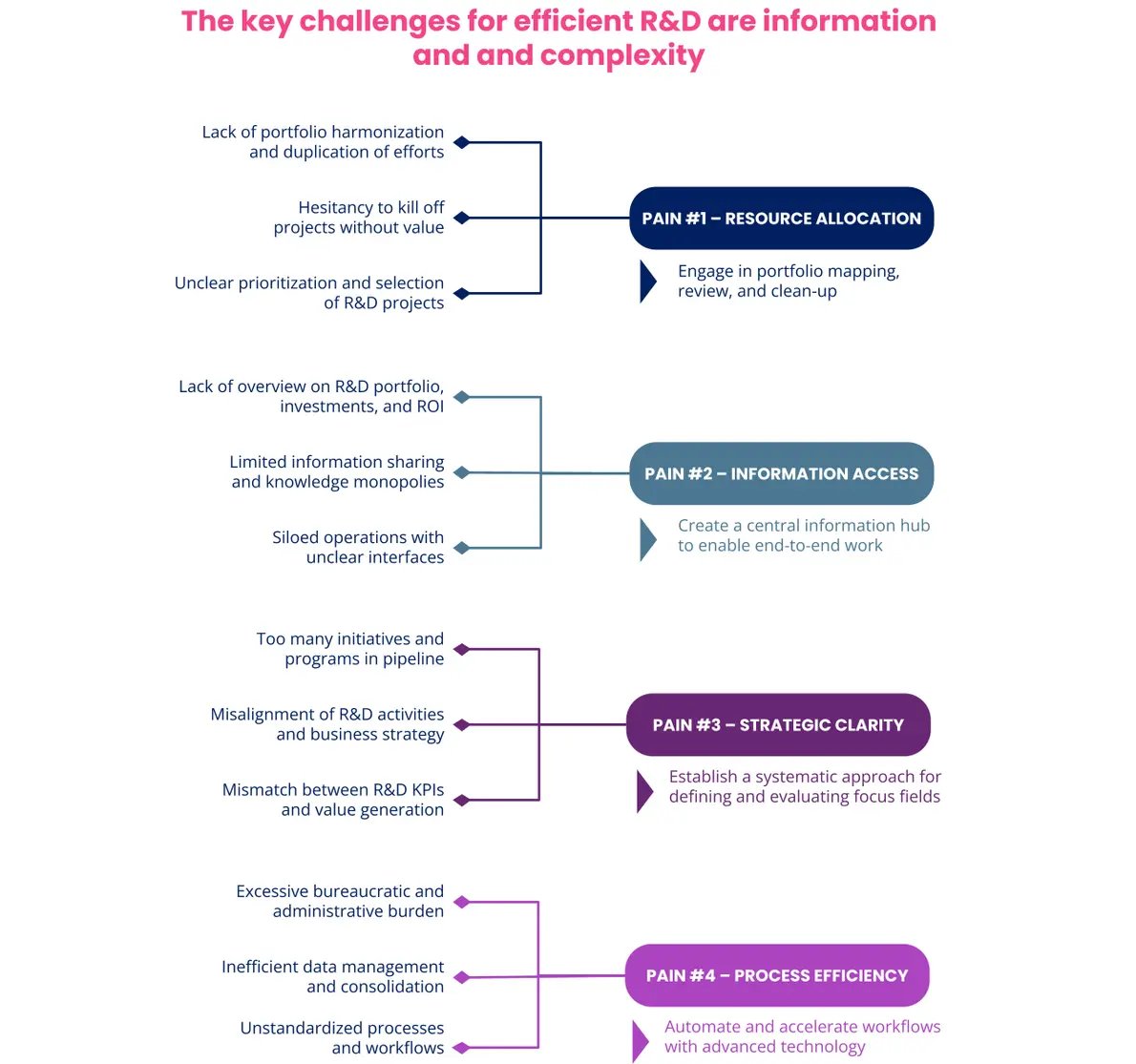
#1 Engage in portfolio mapping, review, and clean-up
Three of the top 5 challenges identified by our sample of R&D executives point to serious struggles in portfolio health: “Lack of portfolio harmonization and duplication of efforts”, “Hesitancy to kill off projects without value”, and “Unclear prioritization and selection of R&D projects”. In sum, those challenges reflect waste and suboptimal usage of R&D resources, be it human workforce, equipment, machinery, or infrastructure.
While proactive portfolio management appears as the obvious cure to those issues, many companies still do not dedicate appropriate attention to this topic. Only 16% of R&D leaders are satisfied with the maturity of their companies’ R&D portfolio management, according to research from Gartner (Gartner, 2019).
For R&D executives trying to improve the efficacy of their R&D portfolio, we recommend starting by creating a visual map of the programs, projects, and initiatives running in their organization. You can only manage what you can see – and thus, this mapping will help you spot initial areas of improvement, such as overlapping projects, orphaned initiatives, or an imbalance of project volumes across strategic objectives. To support you in the process, you can refer to our portfolio mapping template, which is available for download.
After the initial mapping, a more detailed analysis follows in the form of a portfolio review. This process is about putting all running initiatives through a thorough and systematic evaluation – assessing project health, projected value, and resource usage. In addition, assess potential synergies, roadblocks, and overlaps between R&D projects to spot potential for portfolio clean-up. Doing this in a systematic approach allows for transparency, but also helps justify difficult decisions on when and whether to kill a project. If you need some inspiration on how to evaluate R&D projects and make informed decisions, check out our project scoring template.
Overall, a thorough clean-up of the R&D portfolio usually has a significant effect on resource optimization. One of our clients, an international industrial corporation, achieved €800,000 in savings in a month’s time without cutting any value potentials from their R&D pipeline. They simply analyzed a handful of R&D streams for thematic project overlaps, identified synergies, and consolidated the running initiatives. To speed up the work, they relied on the portfolio management functionalities in the ITONICS Innovation OS, including dynamic portfolio visualizations, project templates and workflows, duplicate detection, and much more.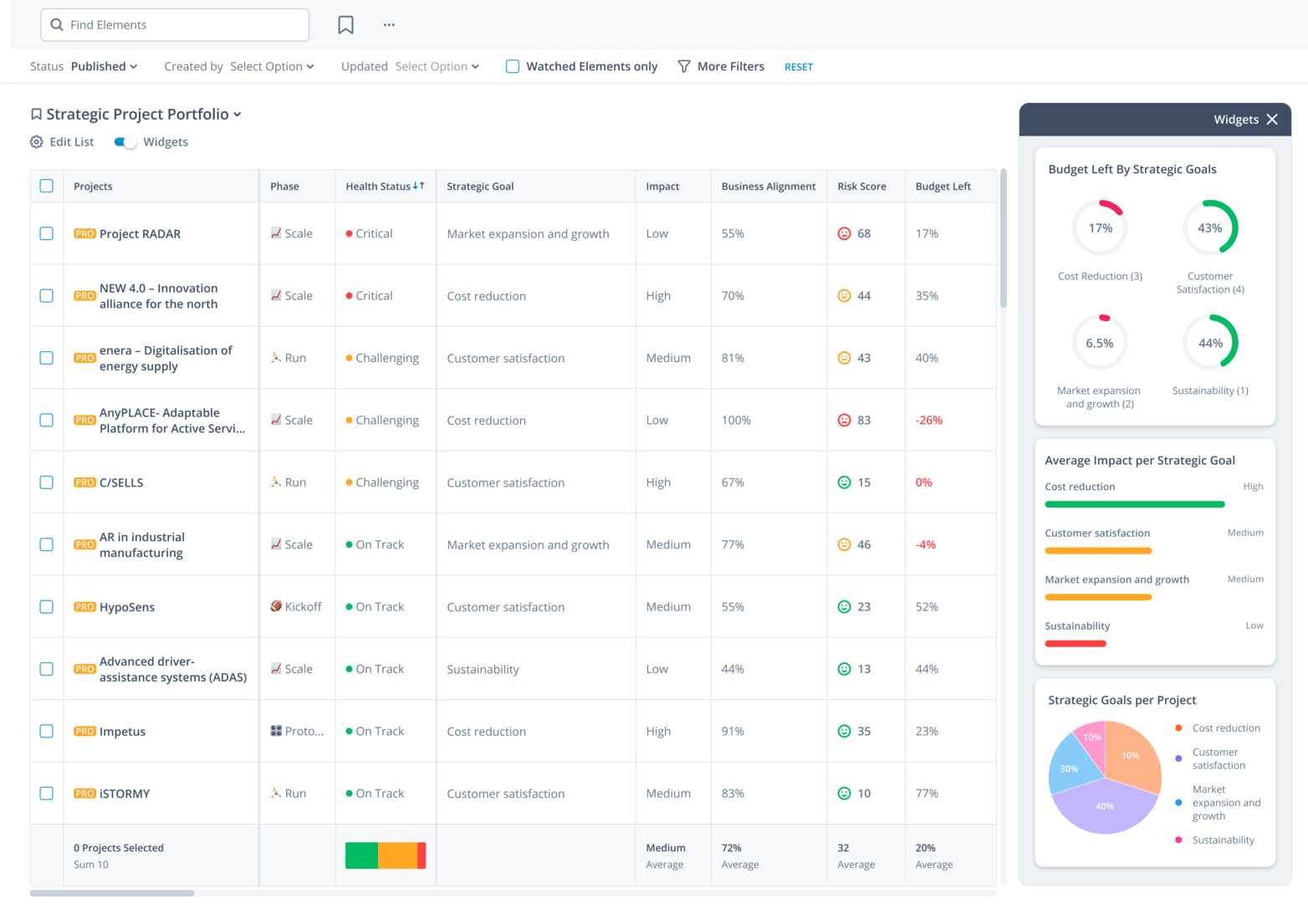
#2 Create a central information hub for enabling end-to-end work
R&D teams need to keep track of a broad number of data and information to work effectively: technical documentation, market reports, customer feedback, product benchmarks, and project plans, just to name a few. This vast amount of information is usually stored decentral on personal devices, share points, or department-specific platforms with little to no tracking of version history, notable updates, or internal consistency. This heap of information is a major roadblock for coordination across R&D units and feeds into the problems described by our study respondents: “lack of overview on R&D portfolio, investments, and ROI,” “limited information sharing and knowledge monopolies,” and “siloed operations with unclear interfaces.”
To keep oversight of all relevant data, break down silos, and enable seamless coordination in daily operations and beyond, R&D leaders need to establish a solid information infrastructure to act as the “stable backbone” within dynamic development processes. Catering to that need, companies across industries have recently implemented digital platforms to act as a central hub for all R&D-related data, information, and knowledge. To ensure that those platforms do not turn into just another information sink but can truly act as a single point of truth for R&D operations, companies should watch out for the following capabilities and requirements:
- End-to-end integration, allowing for centralizing and connecting all R&D-relevant information from initial technology scouting to product go-to-market.
- Real-time data, allows for keeping people across locations, units, and teams up-to-date and providing R&D leadership with robust oversight on what is happening at any point in time.
- Easy-to-use interface, allowing for engagement and collaboration across R&D teams by sharing, enriching, and commenting on insights, technologies, initiatives, and all other relevant information.
- Aggregation and visualization, allowing in-depth analysis of the R&D portfolio and the creation of dynamic reporting systems.
Companies in many sectors have already achieved notable improvements through the implementation of an end-to-end operating system for their R&D activities. Take, for instance, our client Toyota Motor Europe who has set out to streamline all European manufacturing centers to maximize research and innovation efficiency. Centralizing over 200 R&D projects in one platform connected to all relevant technology, market trends, partner, and competitor information, Toyota has created a single source of information for R&D teams located in Europe - achieving significant cost savings in the process. You can find the full Toyota case study here.
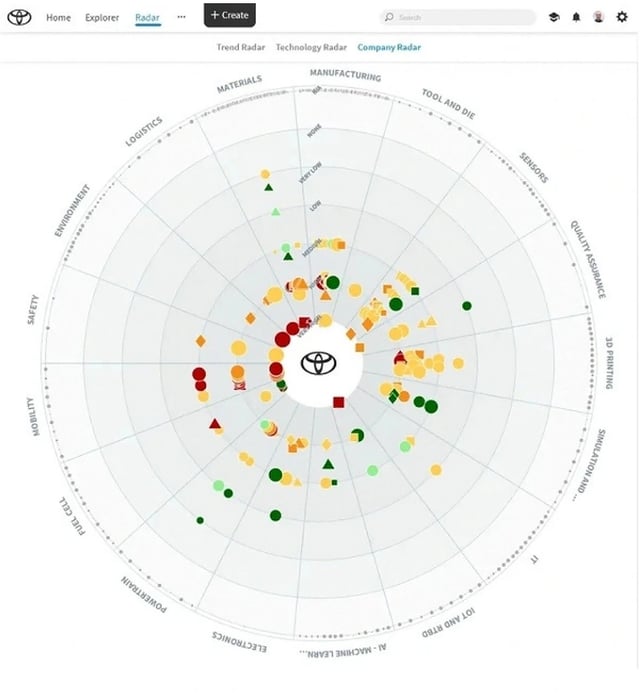
#3 Establish a systematic approach for defining and evaluating focus fields
In most companies, a growing complexity of requirements usually leads to a growing number of initiatives, programs, and projects. This, however, also results in many projects being underfunded, resources being stretched too thinly, and inefficiency due to a lack of alignment and coordination. In a study with over 8,000 managers about strategy and innovation execution, for instance, only 11% of executives reported that strategic priorities and innovation areas have the resources required to succeed (HBR, 2015). Likewise, the respondents of our research mentioned “too many initiatives and programs in the pipeline”, “misalignment between R&D activities and business strategy”, and “mismatch between R&D KPIs and value generation” as key challenges in optimizing R&D resources.
To ensure that scarce resources are focused and allow for creating synergies, the rigorous orientation of R&D activities toward strategic focus fields is mandatory. Our experience shows that even larger companies are unable to address more than 3 to 5 core topics at a time without severely hampering operational efficiency. So, we advise companies to carefully gather, evaluate, and select the most promising areas of opportunity for their R&D programs and enforce the alignment of R&D activities toward those. In the process, tools like our Opportunity Space Canvas can be a great guide.
From our experience working with the top innovators across the globe, we see it as a best practice to always formulate focus fields with a specific business outcome included. A client example from the industrial equipment sector can be seen in the image below. Formulating strategic focus fields will help members of the R&D organization align toward actual value creation. What’s more, outcome-oriented focus fields serve as a great starting point for defining outcome-oriented KPIs - breaking the mismatch between incentives and business values in R&D.
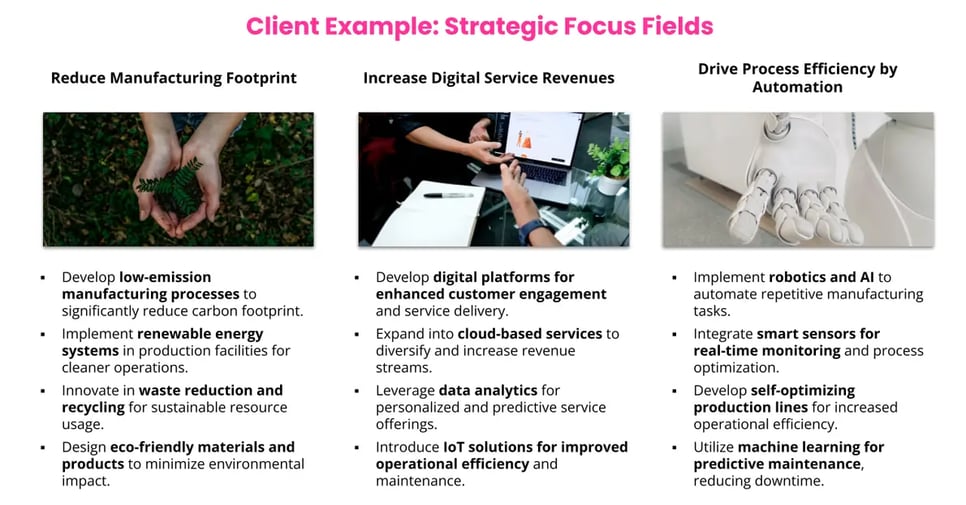
#4 Automate and accelerate workflows with advanced technology
As the final three of the top challenges to R&D resource optimization, R&D executives named “excessive administrative and bureaucratic burden,” “inefficient data management and consolidation”, and “unstandardized processes and workflows.” All of those point to a large share of low value tasks still prevailing in most R&D organizations. In fact, other research done by ITONICS shows that R&D executives and professionals spend up to 50% of their work time on tasks that could easily be automated or accelerated. The key to increasing process efficiency lies in lifting this burden from their shoulders - utilizing the potential of advanced technology.
In terms of automation, many tasks in R&D that are currently done manually and often very time-consuming can be taken over by tools employing artificial intelligence. To provide some examples, first, many research and technology scouting tasks can be sped up tremendously with the help of AI-enhanced signal feeds, scanning and synthesizing all relevant information available on specific topics of interest. Second, by using GenAI assistants to synthesize relevant information and generate text descriptions swiftly and accurately, many reporting and documentation tasks can be trimmed from taking hours to minutes. Third, AI tools can help in prototype generation and concept validation, facilitating not just the birth of innovative concepts but also ensuring their resonance with customers.
In terms of acceleration, digital platforms help you streamline R&D processes, ensuring data consistency and standardized ways of working in R&D operations. Too often, R&D teams rely on different workflows, track different information in project execution, and report metrics based on gut feeling. Curing those issues, it is important to enforce standards but also make it easy for every R&D team to follow the rules in a time-efficient manner - precisely what an end-to-end operating system with project and workflow templates can provide.
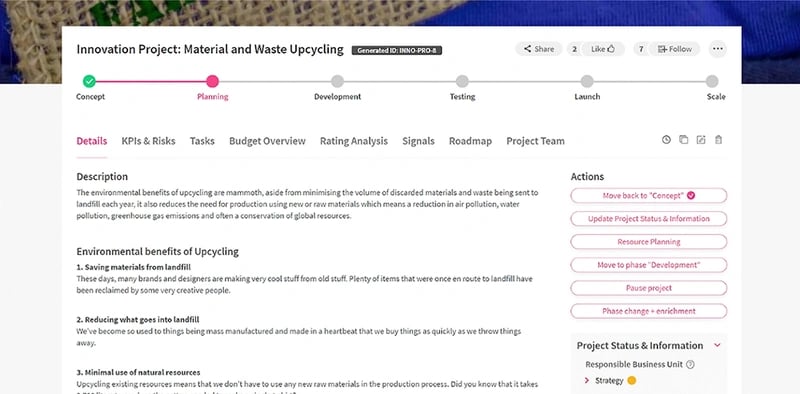
R&D portfolio management with ITONICS
The ITONICS Innovation OS offers a full suite of portfolio management tools, empowering CTOs and innovation leaders to monitor R&D programs, projects, and initiatives. Designed to streamline project work and deliver a full executive overview, these tools include dynamic matrix and Kanban board visualizations, interactive dashboards and roadmaps, customizable workflows, and much more. Create your single point of truth for tracking your innovation investments, optimizing resource allocation, and boosting R&D productivity.
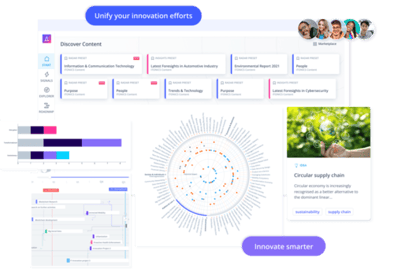
See the ITONICS Innovation OS in action





